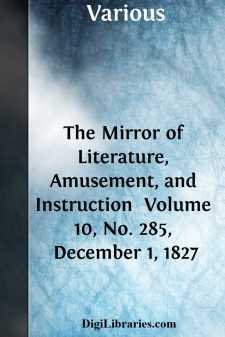Categories
- Antiques & Collectibles 13
- Architecture 36
- Art 48
- Bibles 22
- Biography & Autobiography 813
- Body, Mind & Spirit 142
- Business & Economics 28
- Children's Books 15
- Children's Fiction 12
- Computers 4
- Cooking 94
- Crafts & Hobbies 4
- Drama 346
- Education 46
- Family & Relationships 57
- Fiction 11829
- Games 19
- Gardening 17
- Health & Fitness 34
- History 1377
- House & Home 1
- Humor 147
- Juvenile Fiction 1873
- Juvenile Nonfiction 202
- Language Arts & Disciplines 88
- Law 16
- Literary Collections 686
- Literary Criticism 179
- Mathematics 13
- Medical 41
- Music 40
- Nature 179
- Non-Classifiable 1768
- Performing Arts 7
- Periodicals 1453
- Philosophy 64
- Photography 2
- Poetry 896
- Political Science 203
- Psychology 42
- Reference 154
- Religion 513
- Science 126
- Self-Help 84
- Social Science 81
- Sports & Recreation 34
- Study Aids 3
- Technology & Engineering 59
- Transportation 23
- Travel 463
- True Crime 29
The Mirror of Literature, Amusement, and Instruction Volume 10, No. 285, December 1, 1827
by: Various
Categories:
Description:
Excerpt
CASTLE OF THE SEVEN TOWERS AT CONSTANTINOPLE
1. Triumphal Arch of Constantine.
2. First Tower of the Pentagon.
3. First Marble Tower.
4. Second Marble Tower.
5. Angle of the Pentagon with the fallen Tower.
6. Double Tower.
7. Dedecagonal tower.
8. Square Tower of entrance to the Prison.
9. Round Tower falling to decay.
10. House of the Aga, &c.
11. Garden of the Aga's House.
12. Cemetery of the Martyrs.
The celebrity of the Seven Towers in European countries, though strongly savouring of romance, is no joke—it being the prison where the Turks confine the ministers and ambassadors of the powers with whom they are at war. At the present moment this engraving will doubtless be acceptable to our readers; especially to such of our City friends as have recently been induced to speculate on the heads of ambassadors of the allied powers; and a few days since it might have served as a scale for their wagering the "price of blood."
With the early account of this castle we shall be brief. It is cited in the history of the lower empire from the sixth century of the Christian era, as a point which served for the defence of Constantinople. The embrasures of some of its towers, as well as of the towers that flank the ramparts of the town from the southern angle of the castle to the sea, blackened as is supposed by the Greek fire, announce that it was the principal bulwark of the city on the side of the Propontis, in the latter times of the empire. In 1453, Mahomet II., after an obstinate siege, gained possession of Constantinople and the Castle of the Seven Towers, fear opening to him one of the gates of the latter. The Turks relate that 12,000 men perished in this siege; and the marks of the ravages of the artillery are still visible, for, as usual, the conqueror did not concern himself about repairs. Since that time the place has been the arena of many remarkable events, among which was the tragical murder of the caliph Osman the Second. This has been followed up by many bloody executions; and at every turn gloomy sentiments, and the proud names of Turks and Greek princes, inscribed on the walls, speak the sad fate of those by whose hands they were traced. Towers filled with irons, chains, ancient arms, tombs, ruins, dungeons, cold and silent vaults, a pit called the well of blood, the funeral cry of owls and of vultures, mingled with the roar of the waves—such are the objects and sounds with which the eye and ear are familiarized in these dreary abodes, according to poor Ponqueville, the traveller, who speaks from experience—within the walls. All this is a sorry picture for the
"—Gentlemen of England,
Who live at home at ease."
But the state purposes to which the Seven Towers are appropriated boast of comparative comfort, "the prisoners detained here being distinguished from all other prisoners of war by an allowance for the table which is assigned them by the sultan, and by the appellation of mouzafirs, or hostages. It may, indeed," continues our traveller, "be considered as a great favour to be regarded in this light, comparing their situation with that of others, who fall into captivity among the Turks." Moreover, this castle is dignified as an imperial fortress, and governed by an aga with a guard and a band of music....












